
Queensferry, also called South Queensferry or simply "The Ferry", is a town to the west of Edinburgh, Scotland. Traditionally a royal burgh of West Lothian, it is now administered by the City of Edinburgh Council. It lies ten miles to the north-west of Edinburgh city centre, on the shore of the Firth of Forth between the Forth Bridge, Forth Road Bridge and the Queensferry Crossing. The prefix South serves to distinguish it from North Queensferry, on the opposite shore of the Forth. Both towns derive their name from the ferry service established by Queen Margaret in the 11th century, which continued to operate at the town until 1964, when the Road Bridge was opened.

Haymarket is an area of Edinburgh, Scotland. It is in the west of the city centre and is the junction of several main roads, notably Dalry Road, Corstorphine Road, and Shandwick Place. Haymarket contains a number of pubs, cafés and restaurants.

Princes Street Gardens are two adjacent public parks in the centre of Edinburgh, Scotland, lying in the shadow of Edinburgh Castle. The Gardens were created in the 1820s following the long draining of the Nor Loch and building of the New Town, beginning in the 1760s.
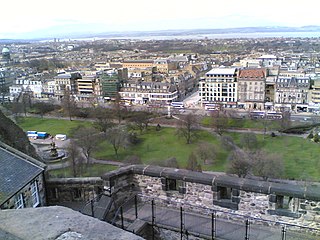
The New Town is a central area of Edinburgh, the capital of Scotland. It was built in stages between 1767 and around 1850, and retains much of its original neo-classical and Georgian period architecture. Its best known street is Princes Street, facing Edinburgh Castle and the Old Town across the geological depression of the former Nor Loch. Together with the West End, the New Town was designated a UNESCO World Heritage Site alongside the Old Town in 1995. The area is also famed for the New Town Gardens, a heritage designation since March 2001.
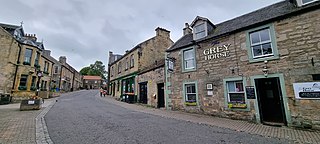
Balerno is a village on the outskirts of Edinburgh, Scotland situated 8 miles south-west of the city centre, next to Currie and then Juniper Green. Traditionally in the county of Midlothian it now administratively falls within the jurisdiction of the City of Edinburgh Council. The village lies at the confluence of the Water of Leith and the Bavelaw Burn. In the 18th and 19th century, the area was home to several mills using waterpower. In the 20th century, the mills closed and the village now forms a residential suburb of Edinburgh.
John Adam was a Scottish architect, building contractor and supervisor.

St Mary's Music School is a music school in Scotland in the West End of Edinburgh, for children aged 9 to 19 and is also the Choir School of St Mary's Episcopal Cathedral. The school, which is non-denominational, provides education for children with a special talent in music, and is Scotland's only full-time independent specialist music school. In 2023 the school has 64 pupils from many different backgrounds and from all parts of Scotland, the rest of the UK and abroad –

Dalmahoy is a hotel and former country house near Edinburgh, Scotland. It is located off the A71 road, 3.5 kilometres (2.2 mi) south of Ratho. The house is protected as a category A listed building,

The colony houses of Edinburgh were built between 1850 and 1910 as homes for artisans and skilled working-class families by philanthropic model dwellings companies. The first development was the Pilrig Model Buildings, near Leith Walk. Later developments across the city were built by the Edinburgh Cooperative Building Company Limited, founded in 1861. The founders of this company were influenced by the Reverend Dr. James Begg and the Reverend Dr. Thomas Chalmers, ministers of the Free Church of Scotland, who campaigned to improve the housing conditions of the poor.
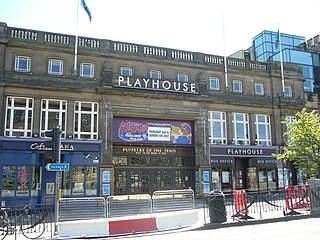
Edinburgh Playhouse is a theatre in Edinburgh, Scotland. With 3,059 seats it is the largest in Scotland and second largest theatre in the United Kingdom, after the Hammersmith Apollo. The theatre is owned by Ambassador Theatre Group.
Venlaw Castle, also known as Smithfield Castle, lies north of Peebles on the Edinburgh Road in the Borders of Scotland. Since 1949, it has been operated as a hotel. It was designated in 1971 as a Category A listed building.
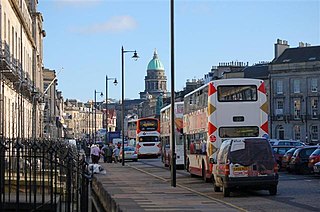
The West End is an affluent district of Edinburgh, Scotland, which along with the rest of the New Town and Old Town forms central Edinburgh, and Edinburgh's UNESCO World Heritage Site. The area boasts several of the city's hotels, restaurants, independent shops, offices and arts venues, including the Edinburgh Filmhouse, Edinburgh International Conference Centre and the Caledonian Hotel. The area also hosts art festivals and crafts fairs.
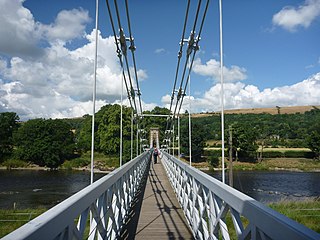
Gattonside is a small village in the Scottish Borders. It is located 1 kilometre (0.62 mi) north of Melrose, on the north side of the River Tweed. In 1143, the lands of Gattonside were granted to the monks of Melrose Abbey by King David I.

Craig House is a historic house and estate located on Easter Craiglockhart Hill, between the Craiglockhart and Morningside areas of Edinburgh, Scotland. Old Craig House dates from the 16th century, and succeeded an earlier building. In the late 19th century it was purchased by the Royal Edinburgh Hospital, and the site was developed as Craig House Hospital, a psychiatric hospital, including substantial new buildings. Following refurbishment, the site was opened in 1996 as the Craighouse Campus of Edinburgh Napier University.
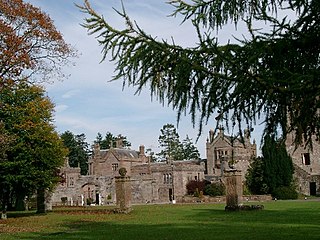
Hoddom Castle is a large tower house in Dumfries and Galloway, south Scotland. It is located by the River Annan, 4 kilometres (2.5 mi) south-west of Ecclefechan and the same distance north-west of Brydekirk in the parish of Cummertrees. The castle is protected as a category A listed building.
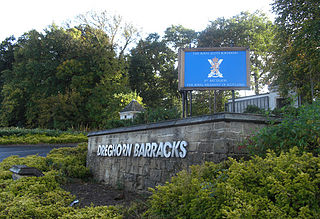
Dreghorn Barracks are located in Edinburgh, Scotland. The barracks are situated at the southern edge of the city, south of Colinton, and adjacent to the Edinburgh City Bypass.

Sundrum Castle is a Scottish medieval castle located 1.5 kilometres (0.93 mi) north of Coylton, South Ayrshire, by the Water of Coyle river. It was built in the 14th century for Sir Duncan Wallace, Sheriff of Ayr. The castle was inherited by Sir Alan de Cathcart, who was the son of Duncan's sister. The Cathcarts sold Sundrum in the 18th century, where it eventually fell into the possession of the Hamilton family. The Hamiltons expanded the castle in the 1790s, incorporating the original keep into a mansion.
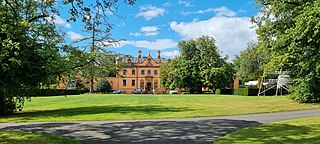
Bonnington House is a 19th-century country house near Wilkieston, around 16 kilometres (9.9 mi) west of the city centre of Edinburgh, Scotland. It is a category A listed building.
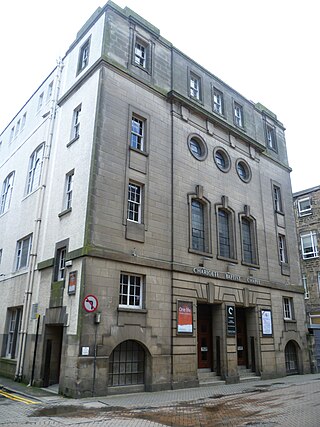
The Rose Theatre is an arts venue and Category B listed building on Rose Street, Edinburgh, Scotland, owned by ballet dancer and Olivier Award winning director Peter Schaufuss and is as a year round venue for theatre, comedy, music, dance and cabaret. It is also the home of the Rose Theatre Cafe. The venue is playing a major role during the Edinburgh Festival Fringe.


















